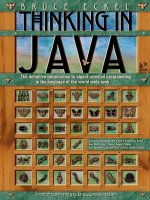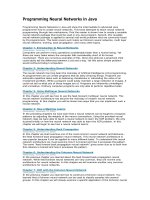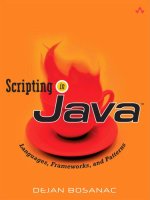scripting in java, 2007
Bạn đang xem bản rút gọn của tài liệu. Xem và tải ngay bản đầy đủ của tài liệu tại đây (3.07 MB, 552 trang )
Scripting in Java
™
Languages, Frameworks, and Patterns
This page intentionally left blank
Scripting in Java
™
Languages, Frameworks, and Patterns
Dejan Bosanac
Upper Saddle River, NJ • Boston • Indianapolis • San Francisco
New York • Toronto • Montreal • London • Munich • Paris • Madrid
Cape Town • Sydney • Tokyo • Singapore • Mexico City
Many of the designations used by manufacturers and sellers to distinguish their products
are claimed as trademarks. Where those designations appear in this book, and the pub-
lisher was aware of a trademark claim, the designations have been printed with initial
capital letters or in all capitals.
The author and publisher have taken care in the preparation of this book, but make no
expressed or implied warranty of any kind and assume no responsibility for errors or
omissions. No liability is assumed for incidental or consequential damages in connection
with or arising out of the use of the information or programs contained herein.
The publisher offers excellent discounts on this book when ordered in quantity for bulk
purchases or special sales, which may include electronic versions and/or custom covers
and content particular to your business, training goals, marketing focus, and branding
interests. For more information, please contact:
U.S. Corporate and Government Sales
(800) 382-3419
For sales outside the United States, please contact:
International Sales
Visit us on the Web: www.awprofessional.com
Library of Congress Cataloging-in-Publication Data
Bosanac, Dejan.
Scripting in java : languages, frameworks, and patterns / Dejan Bosanac.
p. cm.
ISBN 0-321-32193-6 (pbk. : alk. paper) 1. Java (Computer program language)
2. Programming languages (Electronic computers) I. Title.
QA76.73.J38B6715 2007
005.13’3—dc22
2007017654
Copyright © 2008 Pearson Education, Inc.
All rights reserved. Printed in the United States of America. This publication is protected
by copyright, and permission must be obtained from the publisher prior to any prohibit-
ed reproduction, storage in a retrieval system, or transmission in any form or by any
means, electronic, mechanical, photocopying, recording, or likewise. For information
regarding permissions, write to:
Pearson Education, Inc.
Rights and Contracts Department
501 Boylston Street, Suite 900
Boston, MA 02116
Fax: (617) 671-3447
ISBN-13: 978-0-321-32193-0
ISBN-10: 0-321-32193-6
Text printed in the United States on recycled paper at RR Donnelley in Crawfordsville, IN.
First printing August 2007
EDITOR-IN-CHIEF
Mark Taub
ACQUISITIONS
EDITOR
Greg Doench
DEVELOPMENT
EDITOR
Audrey Doyle
MANAGING EDITOR
Gina Kanouse
PROJECT EDITOR
Anne Goebel
COPY EDITOR
Geneil Breeze
INDEXER
Brad Herriman
PROOFREADER
Water Crest
Publishing, Inc.
PUBLISHING
COORDINATOR
Michelle Housley
COVER DESIGNER
Chuti Prasertsith
COMPOSITION
Bumpy Design
D
D
EDIC
EDIC
A
A
TION
TION
To Ivana, for being so lovely
This page intentionally left blank
C
C
ONTENTS
ONTENTS
PREFACE XVII
PART I1
C
HAPTER 1INTRODUCTION TO SCRIPTING 3
BACKGROUND 4
D
EFINITION OF A SCRIPTING LANGUAGE 8
COMPILERS VERSUS INTERPRETERS 8
S
OURCE CODE IN PRODUCTION 12
T
YPING STRATEGIES 13
D
ATA STRUCTURES 17
C
ODE AS DATA 19
S
UMMARY 23
SCRIPTING LANGUAGES AND VIRTUAL MACHINES 24
AC
OMPARISON OF SCRIPTING AND SYSTEM PROGRAMMING 26
RUNTIME PERFORMANCE 26
D
EVELOPMENT SPEED 28
R
OBUSTNESS 29
M
AINTENANCE 32
E
XTREME PROGRAMMING 33
THE HYBRID APPROACH 35
AC
ASE FOR SCRIPTING 37
C
ONCLUSION 38
CHAPTER 2APPROPRIATE APPLICATIONS FOR
SCRIPTING LANGUAGES 39
WIRING 40
UNIX SHELL LANGUAGES 41
PERL 43
TCL 43
PROTOTYPING 44
PYTHON 47
CUSTOMIZATION 49
VISUAL BASIC FOR APPLICATIONS (VBA) 50
SOFTWARE DEVELOPMENT SUPPORT 51
PROJECT BUILDING 51
T
ESTING 53
ADMINISTRATION AND MANAGEMENT 55
U
SER INTERFACE PROGRAMMING 58
TK 58
USE CASES 59
WEB APPLICATIONS 59
S
CRIPTING AND UNIX 68
S
CRIPTING IN GAMES 68
ADDITIONAL CHARACTERISTICS 69
EMBEDDABLE 70
E
XTENSIBLE 70
E
ASY TO LEARN AND USE 71
CONCLUSION 72
PART II 75
C
HAPTER 3SCRIPTING LANGUAGES INSIDE THE JVM 77
UNDER THE HOOD 80
S
CRIPTING LANGUAGE CONCEPTS 82
B
EANSHELL 83
GETTING STARTED 83
B
ASIC SYNTAX 86
L
OOSELY TYPED SYNTAX 87
VIII CONTENTS
SYNTAX FLAVORS 88
COMMANDS 91
M
ETHODS 91
O
BJECTS 92
IMPLEMENTING INTERFACES 93
E
MBEDDING WITH JAVA 94
JYTHON 98
GETTING STARTED 98
B
ASIC SYNTAX 101
W
ORKING WITH JAVA 103
I
MPLEMENTING INTERFACES 105
E
XCEPTION HANDLING 107
E
MBEDDING WITH JAVA 108
C
ONCLUSION 109
RHINO 110
GETTING STARTED 110
W
ORKING WITH JAVA 111
I
MPLEMENTING INTERFACES 112
J
AVAADAPTER 114
E
MBEDDING WITH JAVA 114
H
OST OBJECTS 117
C
ONCLUSION 120
GROOVY 120
O
THER SCRIPTING LANGUAGES 122
JRUBY 122
T
CL/JAVA 122
JUDOSCRIPT 122
OBJECTSCRIPT 123
CONCLUSION 123
CONTENTS IX
CHAPTER 4GROOVY 125
WHY GROOVY? 126
I
NSTALLATION 127
R
UNNING GROOVY SCRIPTS 127
USING THE INTERACTIVE SHELL 127
U
SING THE INTERACTIVE CONSOLE 128
E
VALUATING THE SCRIPT FILE 129
COMPILING GROOVY SCRIPTS 130
DEPENDENCIES 131
C
LASSPATH 131
A
NT TASK 132
SCRIPT STRUCTURE 133
COMMAND-LINE ARGUMENTS 136
LANGUAGE SYNTAX 137
JAVA COMPATIBILITY 137
S
TATEMENTS 138
L
OOSE TYPING 138
T
YPE JUGGLING 140
S
TRINGS 143
GS
TRINGS 145
R
EGULAR EXPRESSIONS 146
C
OLLECTIONS 148
L
OGICAL BRANCHING 154
LOOPING 156
C
LASSES 159
OPERATOR OVERLOADING 162
G
ROOVYBEANS 165
C
LOSURES 168
SYSTEM OPERATIONS 178
FILES 178
P
ROCESSES 182
XCONTENTS
EMBEDDING WITH JAVA 184
S
ECURITY 190
C
ONCLUSION 194
CHAPTER 5ADVANCED GROOVY PROGRAMMING 195
GROOVYSQL 196
groovy.sql.Sql 198
groovy.sql.DataSet 209
GROOVLETS 212
G
ROOVY TEMPLATES 220
G
ROOVYMARKUP 223
groovy.xml.MarkupBuilder 224
groovy.util.NodeBuilder 227
groovy.xml.SaxBuilder 230
groovy.xml.DomBuilder 232
groovy.xml.Namespace 234
groovy.util.BuilderSupport 235
GROOVY AND SWING 236
TableLayout 239
TableModel 241
CONCLUSION 243
CHAPTER 6BEAN SCRIPTING FRAMEWORK 245
INTRODUCTION TO THE BEAN SCRIPTING FRAMEWORK 246
G
ETTING STARTED 247
B
ASIC CONCEPTS 248
ARCHITECTURE 248
R
EGISTRATION OF SCRIPTING LANGUAGES 249
M
ANAGER AND ENGINE INITIALIZATION 252
W
ORKING WITH SCRIPTS 253
WORKING WITH SCRIPT FILES 257
CONTENTS XI
METHODS AND FUNCTIONS 259
call() 259
apply() 263
DATA BINDING 264
REGISTERING BEANS 265
D
ECLARING BEANS 268
COMPILATION 270
A
PPLICATIONS 275
JSP 275
X
ALAN-J (XSLT) 280
CONCLUSION 288
PART III 289
C
HAPTER 7PRACTICAL SCRIPTING IN JAVA 291
UNIT TESTING 292
JUNIT BASICS 293
T
HE GroovyTestCase CLASS 296
A
SSERTION METHODS 297
T
EST SUITES 300
S
CRIPTS AS UNIT TEST CASES 303
S
UMMARY 304
INTERACTIVE DEBUGGING 304
B
UILD TOOLS (ANT SCRIPTING) 309
BSF SUPPORT 313
G
ROOVYMARKUP (ANTBUILDER)316
SUMMARY 322
SHELL SCRIPTING 323
CLASSPATH 324
E
XAMPLE 325
ADMINISTRATION AND MANAGEMENT 328
C
ONCLUSION 334
XII CONTENTS
CHAPTER 8SCRIPTING PATTERNS 335
SCRIPTED COMPONENTS PATTERN 337
PROBLEM 337
S
OLUTION 338
C
ONSEQUENCES 339
S
AMPLE CODE 340
R
ELATED PATTERNS 341
MEDIATOR PATTERN (GLUE CODE PATTERN)341
PROBLEM 341
S
OLUTION 342
C
ONSEQUENCES 345
S
AMPLE CODE 345
R
ELATED PATTERNS 354
SCRIPT OBJECT FACTORY PATTERN 354
PROBLEM 355
S
OLUTION 355
C
ONSEQUENCES 356
S
AMPLE CODE 356
R
ELATED PATTERNS 359
OBSERVER (BROADCASTERS)PATTERN 359
PROBLEM 359
S
OLUTION 360
C
ONSEQUENCES 362
SAMPLE CODE 362
R
ELATED PATTERNS 369
EXTENSION POINT PATTERN 369
PROBLEM 369
S
OLUTION 370
C
ONSEQUENCES 370
SAMPLE CODE 371
R
ELATED PATTERNS 374
CONTENTS XIII
ACTIVE FILE PATTERN 375
PROBLEM 375
S
OLUTION 375
C
ONSEQUENCES 375
SAMPLE CODE 376
CONCLUSION 380
PART IV 383
C
HAPTER 9SCRIPTING API 385
MOTIVATION AND HISTORY 386
I
NTRODUCTION 388
G
ETTING STARTED 390
A
RCHITECTURE 391
D
ISCOVERY MECHANISM 391
E
NGINE METADATA 393
C
REATING AND REGISTERING SCRIPTING ENGINES 395
CREATION METHODS 396
R
EGISTRATION METHODS 399
EVALUATION 400
ScriptException 403
B
INDING 404
ENGINE SCOPE 405
G
LOBAL SCOPE 411
S
CRIPT CONTEXT 416
CODE GENERATION 428
OUTPUT STATEMENT 429
M
ETHOD CALL SYNTAX 429
P
ROGRAM 431
ADDITIONAL ENGINE INTERFACES 432
INVOCABLE 432
C
OMPILABLE 437
XIV CONTENTS
THREADING 440
D
YNAMIC BINDINGS 442
C
ONCLUSION 445
CHAPTER 10 WEB SCRIPTING FRAMEWORK 447
ARCHITECTURE 448
CONTEXT 448
S
ERVLET 449
I
NTERACTION 451
GETTING STARTED 453
C
ONFIGURATION 456
DISABLE SCRIPTING 456
S
CRIPT DIRECTORY 457
S
CRIPT METHODS 458
A
LLOW LANGUAGES 459
D
ISPLAY RESULT 460
BINDINGS 462
APPLICATION 462
R
EQUEST 464
R
ESPONSE 468
S
ERVLET 468
INCLUDE METHOD 469
F
ORWARD METHOD 471
S
ESSION SHARING 473
L
ANGUAGE TAGS 478
T
HREADING ISSUES 481
A
RCHITECTURAL CHALLENGES 482
INTEGRATION OF JAVA AND PHP APPLICATIONS 482
J
AVA BUSINESS LOGIC IN PHP WEB APPLICATIONS 484
PHP V
IEWS IN JAVA WEB APPLICATIONS 487
CONCLUSION 488
CONTENTS XV
PART V 489
A
PPENDIX AGROOVY INSTALLATION 491
DOWNLOAD INSTRUCTIONS 491
I
NSTALLING GROOVY 492
C
ONFIGURING GROOVY 492
T
ESTING GROOVY 492
APPENDIX BGROOVY IDE SUPPORT 495
INSTALLATION 495
U
SAGE 497
APPENDIX CINSTALLING JSR 223 499
REQUIREMENTS 500
I
NSTALLATION 500
INDEX 503
XVI CONTENTS
P
P
REF
REF
A
A
CE
CE
Java is an excellent object-oriented programming language. It has provided many
benefits to software developers, including a good object-oriented approach, implic-
it memory management, and dynamic linking, among others. These language char-
acteristics are one of the main reasons for Java’s popularity and wide acceptance.
But Java is much more than a programming language; it’s a whole develop-
ment platform. This means that it comes with a runtime environment (JRE), which
provides the virtual machine, and the standardized application programming inter-
faces (APIs) that help developers accomplish most of their desired tasks. The main
advantages of this integrated runtime environment are its true platform independ-
ence and simplification of software development.
On the other hand, scripting languages have played an important role in the
information technology infrastructure for many years. They have been used for all
kinds of tasks, ranging from job automation to prototyping and implementation of
complex software projects.
Therefore, we can conclude that the Java development platform can also bene-
fit from scripting concepts and languages. Java developers can use scripting lan-
guages in areas proven to be most suitable for this technology. This synergy of the
Java platform and scripting languages, as we will see, adds an extra quality to the
overall software development process.
In this book, I describe the concepts behind scripting languages, summarize
solutions available to Java developers, and explore use cases and design patterns
for applying scripting languages in Java applications.
How This Book Is Organized
This book consists of five logical parts.
Part I
The first part of the book comprises two chapters that describe scripting languages
in general:
■ Chapter 1, “Introduction to Scripting”—Here I define the basic character-
istics of scripting languages and compare them to system programming
languages.
XVIII PREFACE
■ Chapter 2, “Appropriate Applications for Scripting Languages”—In this
chapter, I explain the role of traditional (native) scripting languages in the
overall information technology infrastructure. I also discuss tasks for
which scripting languages have been used in various systems over time.
Part II
After discussing the basic concepts and uses of scripting languages, we are ready
to focus on real technologies and solutions for the Java platform. This part of the
book contains the following chapters:
■ Chapter 3, “Scripting Languages Inside the JVM”—I begin this chapter by
covering the basic elements of the Java platform and explaining where
scripting languages fit into it. After that, I describe the main features of
three popular scripting languages available for the Java Virtual Machine
(JVM)—BeanShell, JavaScript, and Python—and how they can be used to
interact with Java applications. At the end of this chapter, I describe other
solutions available for Java developers.
■ Chapter 4, “Groovy”—Here I discuss the Groovy scripting language in
detail. I cover its Java-like syntax and all the scripting concepts built into
this language, and I discuss Groovy’s integration with Java, as well as
some security-related issues.
■ Chapter 5, “Advanced Groovy Programming”—In this chapter, I cover
some of the Groovy extensions that can aid in day-to-day programming
tasks. I also explain how Java programmers can access databases, create
and process XML documents, and easily create simple Web applications
and swing user interfaces, using the scripting-specific features in Groovy
covered in Chapter 4.
■ Chapter 6, “Bean Scripting Framework”—In this chapter, I describe the
general Java scripting framework. In addition to explaining how to imple-
ment general support in your project for any compliant scripting language,
I also discuss some basic abstractions implemented in the Bean Scripting
Framework (BSF) and show some examples of successful uses.
Part III
This part of the book focuses primarily on the use of scripting languages in real
Java projects:
■ Chapter 7, “Practical Scripting in Java”—Here I cover topics related to the
use of scripting for everyday programming tasks, such as unit testing,
interactive debugging, and project building, among others.
■ Chapter 8, “Scripting Patterns”—In this chapter, I discuss Java application
design patterns that involve scripting languages. I show how you can use
scripts to implement some parts of traditional design patterns and intro-
duce some new design patterns specific only to the scripting environment.
I also discuss the pros and cons of these design patterns, as well as their
purpose.
Part IV
In the final part of this book, I cover the “Scripting for the Java Platform” specifi-
cation, which was created according to the Java Specification Request (JSR) 223.
Specifically, I cover two APIs defined by the specification:
■ Chapter 9, “Scripting API”—Here I cover the Scripting API, the standard-
ized general scripting framework for the Java platform. The purpose of this
framework is the same as that of the Bean Scripting Framework, but the
Scripting API brings many new features that the modern scripting frame-
work needs. The Scripting API is a standard part of the Java platform with
the release of Mustang (Java SE 6).
■ Chapter 10, “Web Scripting Framework”—In this chapter, I discuss the
Web Scripting Framework, a framework built on top of the Scripting API
and created to enable scripting languages to generate Web content inside a
servlet container. I explain how native scripting languages, such as PHP,
can be synergized with the Java platform to bring more flexibility in Web
application development.
Part V
At the end of the book, you can find a section comprising three appendixes. The
main purpose of these appendixes is to provide the technical details about installa-
tion and use of certain technologies described in the book:
■ Appendix A, “Groovy Installation”—In this appendix, I describe how to
install, build, and configure the Groovy scripting language. A working
installation of the Groovy interpreter is needed to run the code samples
from the text.
PREFACE XIX
■ Appendix B, “Groovy IDE Support”—In this appendix, I provide instruc-
tions on how to install general Groovy support for Integrated Development
Environments (IDEs).
■ Appendix C, “Installing JSR 223”—Here I describe how to install the refer-
ence implementation (RI) of the JSR 223, which is needed to run examples
from Chapter 10.
I hope you’ll enjoy reading the book.
About the Web Site
This book is extended with a Web site at www.scriptinginjava.net where you can
find the following:
■ Source codes of all examples shown in the book available for download
■ Book news, updates, and additions
■ News and information related to this field of software development
XX PREFACE
A
A
CKNO
CKNO
WLEDGMENTS
WLEDGMENTS
I would like to thank my family, friends, and colleagues for endless patience and
support during the writing of this book. I’m also grateful to the people from
Addison-Wesley for believing in this material and making an excellent atmosphere
to work in, especially my editors, Greg Doench and Ann Sellers. I would also like
to thank all technical reviewers, especially George Jempty, Kevin Davis, and Rich
Rosen. They have provided valuable feedback and helped me keep my focus when I
was stranded. Without Audrey Doyle, this material would be much harder to read.
Thank you for helping me shape the manuscript.
Finally, this book wouldn’t be possible without all developers contributing
their time to projects covered by this material.
A
A
BOUT
BOUT
THE
THE
A
A
UTHOR
UTHOR
Dejan Bosanac is a professional software developer and technology consultant. He
is focused on the integration and interoperability of different technologies, espe-
cially ones related to Java and the Web. Dejan spent a number of years in develop-
ment of complex software projects, ranging from highly trafficked Web sites to
enterprise applications, and was a member of the JSR 223 Expert Group.
PART I
CHAPTER 1 Introduction to Scripting
CHAPTER 2 Appropriate Applications for Scripting
Languages
This page intentionally left blank









